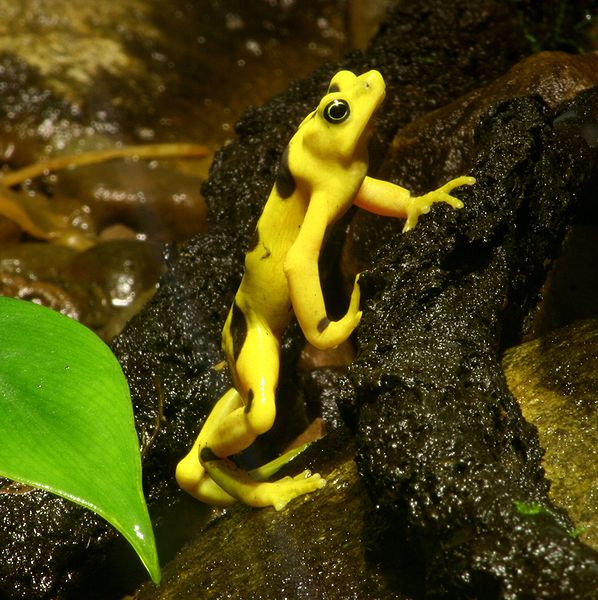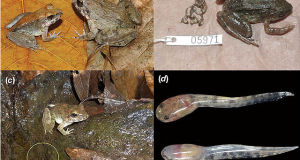 The Borneo Rainbow or Sambas Stream Toad, Ansonia latidisca, is known only from drawings made by its discoverer, and has not been seen in 87 years. Extensive development of its only known habitat has long raised fears of its extinction. This month (July, 2011), however, it became the second of the world’s “Ten Most Wanted” amphibians to be rediscovered.
The Borneo Rainbow or Sambas Stream Toad, Ansonia latidisca, is known only from drawings made by its discoverer, and has not been seen in 87 years. Extensive development of its only known habitat has long raised fears of its extinction. This month (July, 2011), however, it became the second of the world’s “Ten Most Wanted” amphibians to be rediscovered.
“Ten Most Wanted”
In 2010, Conservation International launched the Global Search for Lost Amphibians (please see article below). Since then, several very rare frogs and salamanders have been found, but the tiny Borneo Rainbow Toad has remained elusive. In fact, only one of the 10 species granted highest priority (the Ten Most Wanted) had turned up – Ecuador’s Spotted Stubfoot Toad, Atelopus balios. However, a 3-month-long search of the Gung Penrisser Mountains in Sarawak, western Borneo, revealed that the Rainbow Toad is still with us.
Finding a Long-Lost Amphibian
Prominent herpetologist Indraneil Das, whom I’ve had the pleasure of meeting at several conferences, led the search, which was held after nightfall among trees along high mountain ridges. Despite being brilliantly clad in red, yellow, purple, black and green, the aptly named Rainbow Toad is a mere 2 inches in length, nocturnal, and lives above ground – not an easy creature to find. But Dr. Das’ team prevailed, and 3 individuals were finally located in their arboreal hideaways.
An Uncertain Future
The Borneo Rainbow Toad is known from only two locations and likely has a tiny total range. Unfortunately, most of its habitat has been converted to golf courses and farmland, and the only streams in which its tadpoles were once found are subject to runoff and heavy siltation. Prospects for the creature’s future are dim, but conservation measures are being discussed.
 Most missing and newly-discovered frogs are tiny, drab creatures that, unfortunately, excite only diehard amphibian enthusiasts. The Borneo Rainbow Toad is, however, a beautiful little beast. For this reason, the exact site of its rediscovery is being held in confidence, lest collectors move in.
Most missing and newly-discovered frogs are tiny, drab creatures that, unfortunately, excite only diehard amphibian enthusiasts. The Borneo Rainbow Toad is, however, a beautiful little beast. For this reason, the exact site of its rediscovery is being held in confidence, lest collectors move in.
Other Unusual “New” Frogs
Some surprisingly large and interesting amphibians have been found in recent years, including Thailand’s Bird Eating Frog and the world’s only known Lung-less Frog, a native of Borneo.
Further Reading
Borneo Rainbow Toad Natural History
Drawings and Photos of the Borneo Stream Toad
Photos and info, “Ten Most Wanted Amphibians”
Atelopus certus image referenced from wikipedia and originally posted by Brian Gratwicke
 That Reptile Blog – Reptile, Amphibian and Exotic Pet Care and Information
That Reptile Blog – Reptile, Amphibian and Exotic Pet Care and Information



very interesting frank! Thanks
where do you keep finding these great news 😛
Hello Mike, Frank Indiviglio here.
Thanks…glad you enjoyed.
I’ve been fortunate enough to have worked with herps in zoos all my life, and so have useful personal contacts and an interest that compels me to read some of the professional journals and so on. Lots more coming through on the internet, of course, but some of the odder bits still buried in Herpetologica and the like.
Best regards, Frank Indiviglio.
Do you know what rainbow toads eat abd who they are related to?
Hello Lucy,
The genus to which this toad belongs contains 23 other species found in south and Southeast Asia; none have been well studied. Most live along swift streams that run through forested areas. Only 2 Rainbow Toads have ever been found, so there is no information on their diet; like related species, they are presumed to feed upon small leaf-litter invertebrates such as small ants, termites, springtails and beetles. You cane read more about its natural history here. Best regards, Frank